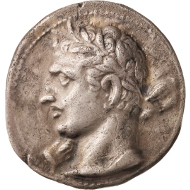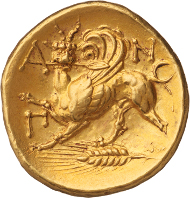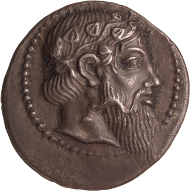13-12-2015 – 01-01-1970
Auction 9: The Joint Collection of Baron Lorne Thyssen-Bornemisza & Dr Thomas S. Kaplan
Masterpieces of Greek Coinage at NGSA
Thirty-five Years of Friendship is the title of the auction, which will be held by Numismatica Genevensis SA at the Hotel Beau-Rivage in Geneva on December 14th, 2015. This very special sale presents “only” 75 lots. Nevertheless, every single piece bears testimony to the deep friendship of two men, which they had fostered since they were young. Baron Lorne Thyssen-Bornemisza and Dr Thomas S. Kaplan went to the same school. Both had a profound interest in history and politics. Since their school days, they have been hotly debating issues of global politics.
Lot 8: Camarina (Sicily). Tetradrachm, ca. 410 BC. Westermark-Jenkins 151 (same die). Ex NAC 48 (2008), 26, as well as NAC 9 (1996), 139. The finest coin from Camarina ever to be struck. Good extremely fine. Estimate: 100,000,- SFr.
Together they assembled the collection of Greek coins now sold by Numismatica Genevensis. Joining best taste and enthusiasm they were able to create one of the most outstanding collections the market has seen in the last decades.
As expected, the Auction “35 Years of Friendship” presents the finest of ancient numismatics one can think about. The quality of this collection becomes evident by taking a closer look at those specimens, which seem to be rather familiar on the first sight, but which never have been seen in such a perfect condition.
Lot 59: Caunos (Caria). Stater, ca. 410-390 BC. K. Konuk, Essays Price 112b (this specimen). Ex Leu 48 (1989), 239, as well as NAC 48 (2008), 98. Good extremely fine. Estimate: 100,000,- SFr.
Let’s take Lot 59 as an example. We all have seen staters from Caunos. On the obverse, it depicts Iris, winged messenger of the gods. Holding a snake-entwined staff and a wreath in her hands, she is rapidly progressing to the left. The reverse is of austere simplicity: It shows a conical baitylos, a cult stone that constituted the heart of many Archaic cults in Asia Minor.
As we said before, this coin type is not rare at all. But look at the perfection with which the die cutter has captured the figure on the coin! How delicately and yet meticulously he has modelled the divine body through the folds of the drapery! How much artistic skill becomes apparent in the tiniest details, as evidenced by the fine toes of the back foot! All together this is truly unparalleled.
Lot 61: Pixodaros, Satrap of Caria, ca. 341/0-336/5 BC. Tetradrachm. Pixodaros 7-8 var. (these dies not listed). Ex Triton 12 (2009), 325. Probably the best specimen of this emission known to exist. Good extremely fine. Estimate: 50,000,- SFr.
The same applies to a tetradrachm of the Carian dynast Pixodaros. Strictly speaking, this coin type is not rare, too. So far, however, not a single specimen of this coin type has been known to exist, whose obverse, struck in high-relief and featuring the facing portrait of Apollo, does not exhibit any traces of wear.
Therefore, it does not come as a surprise that a large number of the coins from this collection have been chosen as cover coins of major auction sales of the past.
Lot 1: Qart Hadasht or Carthago Nova (Hispania). Triple shekel, ca. 221-210/09 BC. CNH 12. Ex NGSA 5 (2008), 161. One of only five specimens known to exist. Good very fine. Estimate: 100,000,- SFr.
We are left with nothing more than to emphasize that this auction sale features not just exceptionally fine coins but also great rarities. We would like to name only a few: the triple shekel from Cartagena with a portrait that is quite likely to represent no one else than Hannibal (five specimens known to exist, of which two are currently housed in museums), a 8 litra piece from Syracuse, which seems to have been issued during the siege of the city by the Romans (two specimens known to exist) …
Lot 42: First Region of Macedonia. Tetradrachm, ca. 168 BC, Amphipolis. Kraay-Morkholm Essays p. 237, 213 (this specimen). Ex Sitochoro / Larissa hoard from 1968 (IGCH 237), ex Leu 22 (1979), 84, ex Leu 50 (1990), 125, as well as NGSA 5 (2008), 79. Only eight specimens of this emission known to exist. Extremely fine. Estimate: 200,000,- SFr.
… a tetradrachm from the First Region of Macedonia which the Romans had divided (eight specimens known to exist), a unique tetradrachm from Chalcis on Euboea from the BDC Collection, and an Archaic tetradrachm from Eretria (third specimen known to exist).
Lot 17: Syracuse (Sicily). Decadrachm, 405-400 BC of Kimon. Jongkees 7 (this specimen). Ex Hirsch 32 (1912), 312. Douplicate from the Berlin Coin Cabinet, separated out in the late 1930s or early 1940s. Ex Dr J. H. Judd Coll., Bank Leu 15 (1976), 118, as well as Leu 71 (1997), 80. Extremely fine. Estimate: 150,000,- SFr.
It hardly needs special mentioning that the collection also features all the highlights from Greek numismatics. Let us single out only a few examples: a tetradrachm from Catane with the facing portrait of Apollo, a Syracusan decadrachm signed by Kimon …
Lot 30: Panticapaeum (Taurian Chersonesos). Stater, ca. 340-330 BC. Gulbenkian 585-586. Ex R. Abecassis Coll., acquired by Spink in 1968, ex J. Abecassis Coll., Leu 81 (2001), 124, as well as NGSA 4 (2006), 84. Good extremely fine. Estimate: 200,000,- SFr.
… a gold stater from Panticapaeum, and a tetradrachm from Rhodes featuring a facing portrait of Apollo.
Lot 47: Eretria (Euboea). Tetradrachm, ca. 525-500 BC. Cahn, Monnaies Grecques Archaiques (Basel 1947), 14 (this specimen). Ex A. Rousopoulos Coll., J. Hirsch 13 (1905), 1896. Ex C. S. Bement Coll., Naville 6 (1923), 1069, ex J. W. Garrett Coll. and John Hopkins University, Bank Leu and NFA (1984), 213, ex BCD Coll., Numismatik Lanz 111 (2002), 306, as well as Nomos Fixed Price List 2008, 306. Third and best graded specimen of this type (the other two are currently owned by museums). Good very fine. Estimate: 150,000,- SFr.
The proceeds of the sale go to the Recanati-Kaplan Foundation as well as the Cogito Scholarship Foundation. Founded by Dr Thomas S. Kaplan and his wife, the Recanati-Kaplan Foundation focuses on the exploration and the preservation of the fauna, with a special emphasis placed on large cats and snakes. It is concerned with medical and social issues, and engages in the education of economic and political leaders in regards to their knowledge about national and international politics. What is more, the foundation supports the Hebrew Charter School Center, a community which teaches U.S. American pupils modern Hebrew.
Lot 13: Naxos (Sicily). Drachm, ca. 450 BC. Cahn 56, 40 (this specimen). Ex Virzi Coll., ex Ars Classica 17 (1934), 175, ex Kunstfreund Coll., Bank Leu & MMAG (1974), 96, as well as Leu 45 (1988), 49. Very rare, particularly in this grade. Good extremely fine. Estimate: 100,000,- SFr.
The Cogito Scholarship Foundation, on the other hand, pursues a different goal. The future of young Arab people is a matter of great personal concern to Baron Lorne Thyssen-Bornemisza. He is co-founder of a foundation which intends to ensure talented pupils from disadvantaged families of the Near East and North Africa access to a pre-university education in the best schools worldwide.
The catalog can be viewed on the internet here. Printed copies may be ordered at Numismatica Genevensis SA, Rond-Point de Plainpalais 1, CH-1205 Genève, phone +41 / 22 / 320 46 40, email.





















